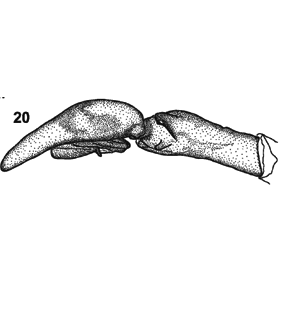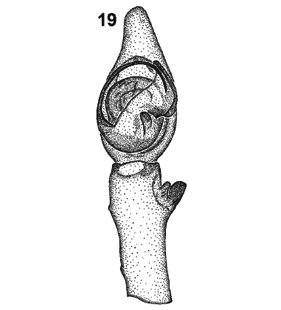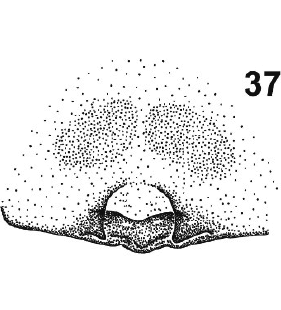Aterigena aspromontensis Bolzern, Haenggi & Burckhardt, 2010
Description
Male
Male palp: RTA with big dorsal branch, distally truncated and strongly sclerotized; lateral branch developed as weakly sclerotized digitiform appendix; ventral branch forming weakly developed rounded ridge. Embolus originating (free apex) between 8 and 9 o’clock position; length (only free apex) less than 1.75 times width of cymbium; distal tip at 2 o’clock position. Conductor lamellalike, distally only weakly elongate (parallel to cymbium), very weakly arched and laterally folded along entire length; shorter than alveolus; distally not reaching beyond distal margin of alveolus; terminal end forming sclerotized peak, pointing ventrally (in retrolateral view). Connection of conductor and tegulum membranous. Median apophysis consisting of membranous base and thin, broad sclerotized distal plate, spoonlike, originating between 4 and 5 o’clock position; protruding ventrodistally. Prosoma length: 3.27 mm.
Female
Epigynum and vulva: Epigynal plate sclerotized with distinct atrium, transversely oval in shape; anterior margin of atrium gradually changing from sclerotized epigynal plate to membranous structure; atrium reaching posteriorly epigastral furrow. Ground plate of atrium transversally subdivided (slightly concave medially): anterior part membranous or weakly sclerotized, semicircular in shape; posterior part stronger sclerotized forming semicircular band. Lateral margin of atrium with elongated vertices. Receptacula visible through plate. Copulatory openings indistinct, located medially of atrium. Copulatory duct short, straight; receptacula small, oval or globular; fertilization ducts short, weakly convoluted. Prosoma length: 3.13–4.26 mm.
Additional information
Eyes: In dorsal view both eye rows straight or slightly recurved; in frontal view PER procurved and AER straight or slightly procurved. Diameters: PME: 0.124–0.143; PLE: 0.143–0.162; AME: 0.095–0.133; ALE: 0.143–0.162. Distances: PME–PME less than diameter of PME; PME–AME less than diameter of PME; PME–PLE equal to diameter of PME; PME–ALE less than 1.5 diameter of PME; AME–AME about 0.5 times diameter of AME or slightly more; AME–ALE about 0.5 times diameter of AME. Clypeus height (measured under AME) less than 2.5 times diameter of AME;(measured under ALE) less than 1.5 times diameter of ALE.
Coloration: Margin of carapace narrowly and continuously dark; two longitudinal symmetrical dark bands on carapace, interrupted and sometimes reduced to triangular dots. Sternum with indistinct light median band. Opisthosoma dark green-grayish, anteriorly with two light and partially fused bands, continuing in fused chevrons posteriorly. Legs weakly annulated, hardly visible on femora ventrally.
Additional somatic characters: distal margin of labium weakly concave. Plumose hairs present on carapace, legs and opisthosoma. Promargin with 4 teeth, second one from proximal largest; retromargin with 4–5, most proximal tooth biggest. Trochanter III and IV notched. Tarsus I with 5–8 dorsal trichobothria, tarsi II–IV with 6–8. Colulus forming rectangular plate, pale, distal margin straight. PLS longer than all others with distal segment shorter than or as long as basal segment, both darkened. PMS as long as ALS. ALS not darkened.
Frequency: only few records known
Distribution
Phenology
| Jan | Feb | Mar | Apr | May | Jun | Jul | Aug | Sep | Oct | Nov | Dec |
 |  |
Figures
Distribution List
"No references" does not mean that the species does not occur in this country, but that we have not yet inserted the reference for it. We are working on it.
References
Bolzern A, Hänggi A, Burckhardt D (2010) Aterigena, a new genus of funnel-web spider, shedding some light on the Tegenaria-Malthonica problem (Araneae: Agelenidae) Journal of Arachnology 38: 162-182 ![]()
Pantini P, Isaia M (2019) Araneae.it: the online catalog of Italian spiders, with addenda on other arachnid orders occurring in Italy (Arachnida: Araneae, Opiliones, Palpigradi, Pseudoscorpionida, Scorpiones, Solifugae). Fragmenta Entomologica 51: 127-152 ![]()
WSC (2025) World Spider Catalog. Version 26. Natural History Museum Bern, online at http://wsc.nmbe.ch (28.2.2025) doi: 10.24436/2 ![]()




